This is part of a 4-part series about increasing employee engagement with employee-generated content.
1) Assessing Your Employee Advocacy Opportunities
2) Strategies for launching your employee advocacy program
3) Benefits of an employee advocacy and EGC social media plan
4) Get more content from your employees
For this blog post, I decided to bring in some outside help from our partners and recruitment experts at TMP Worldwide. Thank you to Allison Kelley, Content Marketer, for adding your expert opinion on why employee generated content is essential for growth minded organizations.
In part one of this series, we discussed the need to assess the current state of your employee advocacy. In part two, let’s dive into the crafting the perfect strategy for getting your employees engaged!
Employee generated content (EGC) is the perfect opportunity for you to share real stories from real employees, which can be an incredibly powerful thing in the current digital climate where 80% of people actively want brands to tell stories.
Letting your employees tell their story is imperative if you want to create an engaged and unified team. In addition, EGC can act as an organic recruitment tool to attract new hires. Just remember that in the world of EGC, your campaign is nothing unless it’s authentic, positive, inclusive and branded. – Allison Kelley
First things first: get your employees on board by being inclusive
You don’t want to have your employee advocates jump through hoops in order to take part in the campaign.
Do that, and they’ll be turned off quicker than you can say “hashtag”.
In fact, you want to make it as simple as possible for them to share their stories about their jobs and your brand with your audience.
How do you do that?
Use a Platform They Know and Have Access To
This isn’t as obvious as you may think. In part one, we discussed assessing what kind of content was already being created by your employees. While some networks, like Twitter and Instagram, are more obvious, there are tons of platforms out there that your employees can use. From corporate tools like Cisco Spark and Slack to custom built mobile apps and internal channels, pick a platform that your employees will a) have access to, and b) willingly use.
Successful platforms are mobile-friendly, too. That’s why social media networks like Instagram and Twitter are so great.
It’s likely your employees will be contributing to the campaign on-the-fly, which means uploading videos, images, and updates from their phones while in the middle of the action.
Basically, you want to make it as easy as possible for everyone involved.
Inclusivity: Ensure that the greatest number of employees will participate and contribute to the campaign by polling them ahead of time. This will give you a good idea of what level of participation they are most comfortable with and what would motivate them to contribute. – Allison Kelley
But more importantly, you want to actively encourage people to get involved.
It’s All About the Process
Your employees aren’t a product.
Instead, they are active contributors to the process.
The aim of a successful EGC campaign is to motivate employees to engage with your brand and talk about things from their perspective.
The process should become a way that your employees can be consistent sources of stories and content.
Authenticity: EGC gives your employees a voice. Whether you choose to do a one-time employee engagement page, or you offer your employees a more permanent [contributor] position, just make sure you are allowing the employee to express themselves in their own words. This, along with on-the-job photos, will help you build an authentic brand image. – Allison Kelley
The best kind of content demonstrates growth, innovation, and camaraderie on your team, and that is a consistent, ongoing process. Think of it like a story, where each new piece of content adds to the plot, develops character, and builds on the storyline.
One-off pieces of content that are sporadically published won’t create a streamlined narrative. Instead, each piece should build on the last to create a bigger picture that reflects your brand, its values, and your employees.
Think About the Prompt, then think about it some more.
The most important part of an EGC campaign is actually getting your employee advocates to take part. If you want to build community within your brand, you have to cultivate that community and provide a place where people want to participate.
TMP and TINT both agree that positivity is how you’re able to generate the more shareable and uplifting content from your employees.
Positivity: Consider all the reasons your employees love where they work. Then harness their excitement by putting it on a platform where others can see it. Internally, it will serve to inspire current employees, and externally, it can appeal to potential job candidates. – Allison Kelley
Something I learned from Belinda Green (Twitter – @BelindaGreen), Head of Planning at Gyro APAC, is that some of the best employee content comes from the engineering and product departments. Encouraging your employees to “geek out” and share videos and pictures of their life in the lab or testing facility will result in content that is relatable with others who care deeply about the innovations the organization is working on.
Just make sure you’re wearing goggles and closed toe shoes – #safetyb4selfie
Once you have a prompt determined, it’s time to create the perfect hashtag to go along with it. As human beings, we like to feel a part of something, and a hashtag creates a virtual space to do exactly that.
Crafting Your Hashtag
Aside from creating a virtual space for your community to grow, social shares with hashtags get twice as much engagement as shares without them and, on top of that, 75% of people on social media use hashtags, so it’ll come as second nature to your employees.
First and foremost, your hashtag should represent your company and its employees. So, if your brand image is fun and carefree, you want your hashtag to reflect that.
It isn’t easy to get it right so here are some quick tips to get you started:
- Keep it short and snappy – your hashtag should be easy to remember, which means keeping it short and to the point. Ideally, you want your hashtag to be two words, but you can push it to three words if absolutely necessary.
- It should be yours – before you go full steam ahead with your hashtag, make sure no one else is using it. You don’t want to pick something that already has a bunch of people posting to it who aren’t a part of your brand.
- Make it make sense – it’s fun choosing a play on words or something punny, but for maximum impact, you want everyone in the company to understand why you picked it in the first place. It should make sense to you, your employees, and your audience.
- Make it Actionable – actionable hashtags are ones that you can include verbs, like #LeanInTogether or #WearYellowforSeth. This is important because it creates a call to action directly within the hashtag and makes it more obvious what type of content your employees should be sharing.
If you need more help, just mention @TINT and use #hashtaghotline on Twitter and we’ll give you some ideas. You should also check out TINT’s guide on crafting a perfect hashtag.
Let’s take a look at some company hashtags that really work.
T-Mobile’s #BeMagenta
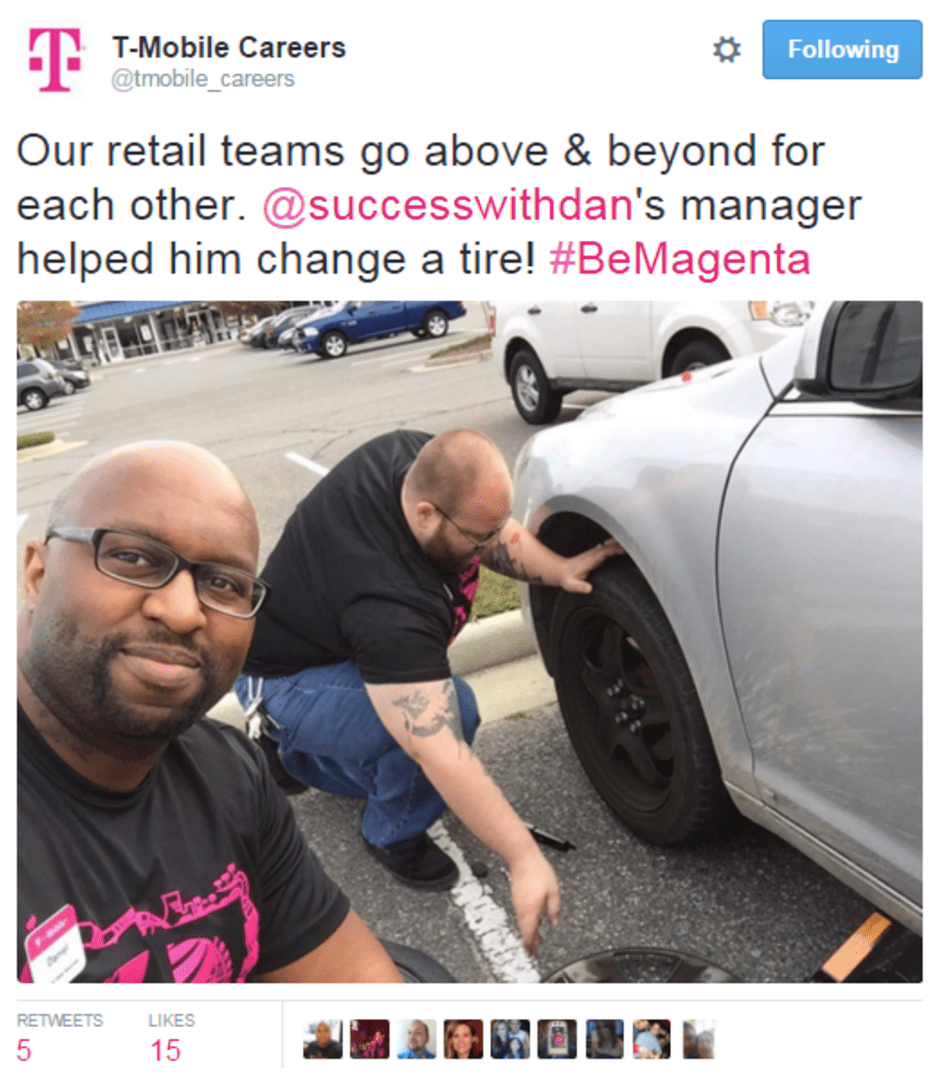
For a fun way to target potential employees in a recruitment campaign, T-Mobile came up with the #BeMagenta campaign, which was an experiential plan that fully reflected the company’s culture and brand.
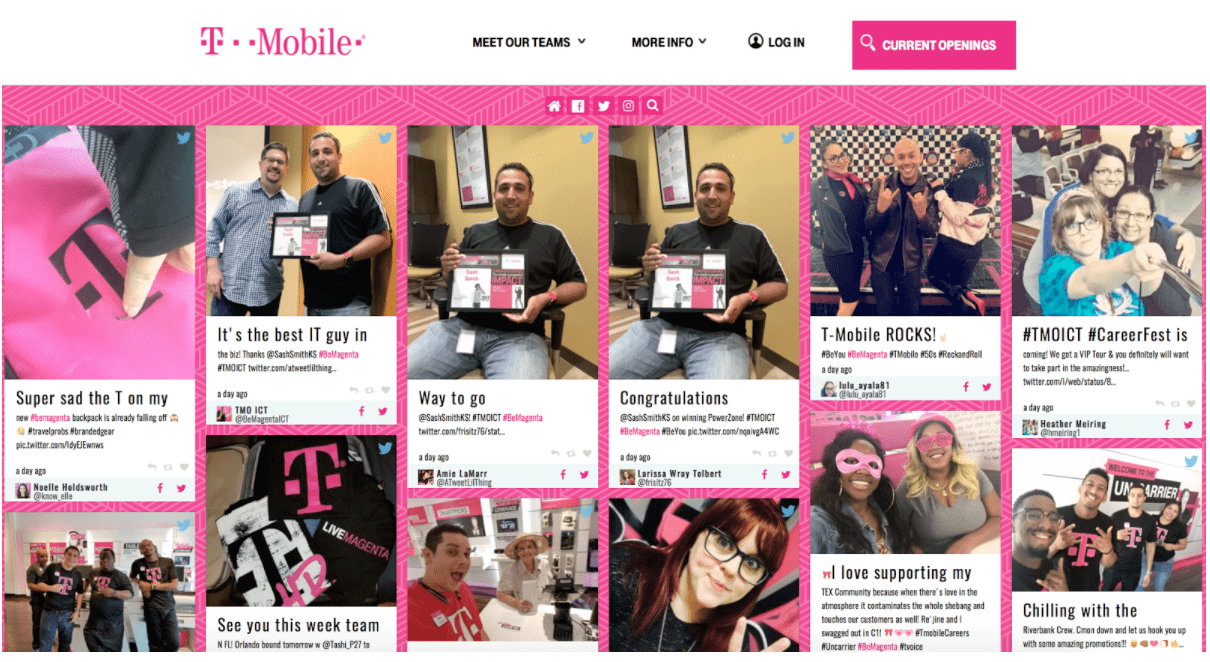
The content created was published on a dedicated web page where it could all be accessed at once, and it led to more than 7,000 engagements over five days and garnered almost one million social media impressions.
Cisco’s #WeAreCisco
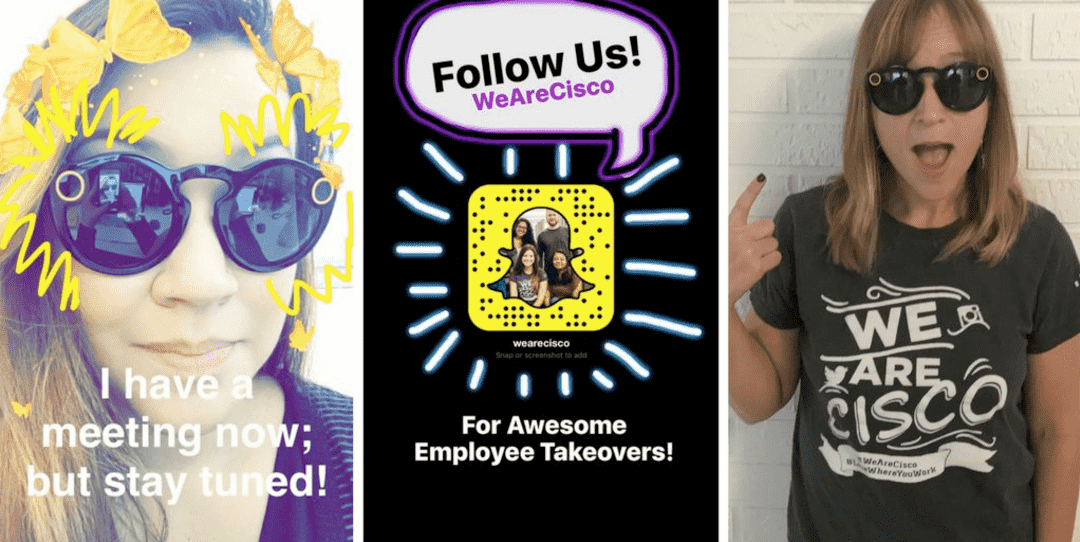
Cisco wanted to tell employee stories to the world in order to connect with their audiences and entice people to work for the brand in the future. Their #WeAreCisco campaign was a huge hit and resulted in more than five million minutes of Snapchat stories viewed and almost one million total views.
TINT’s #TINTLove
The #TINTLove hashtag connects employees to each other and the company by encouraging the team to share their experiences both at work and outside of work.
In the photo below, TINT employees were taking part in a volunteer activity in San Francisco and we showed our #TINTLove for the city by planting some trees.
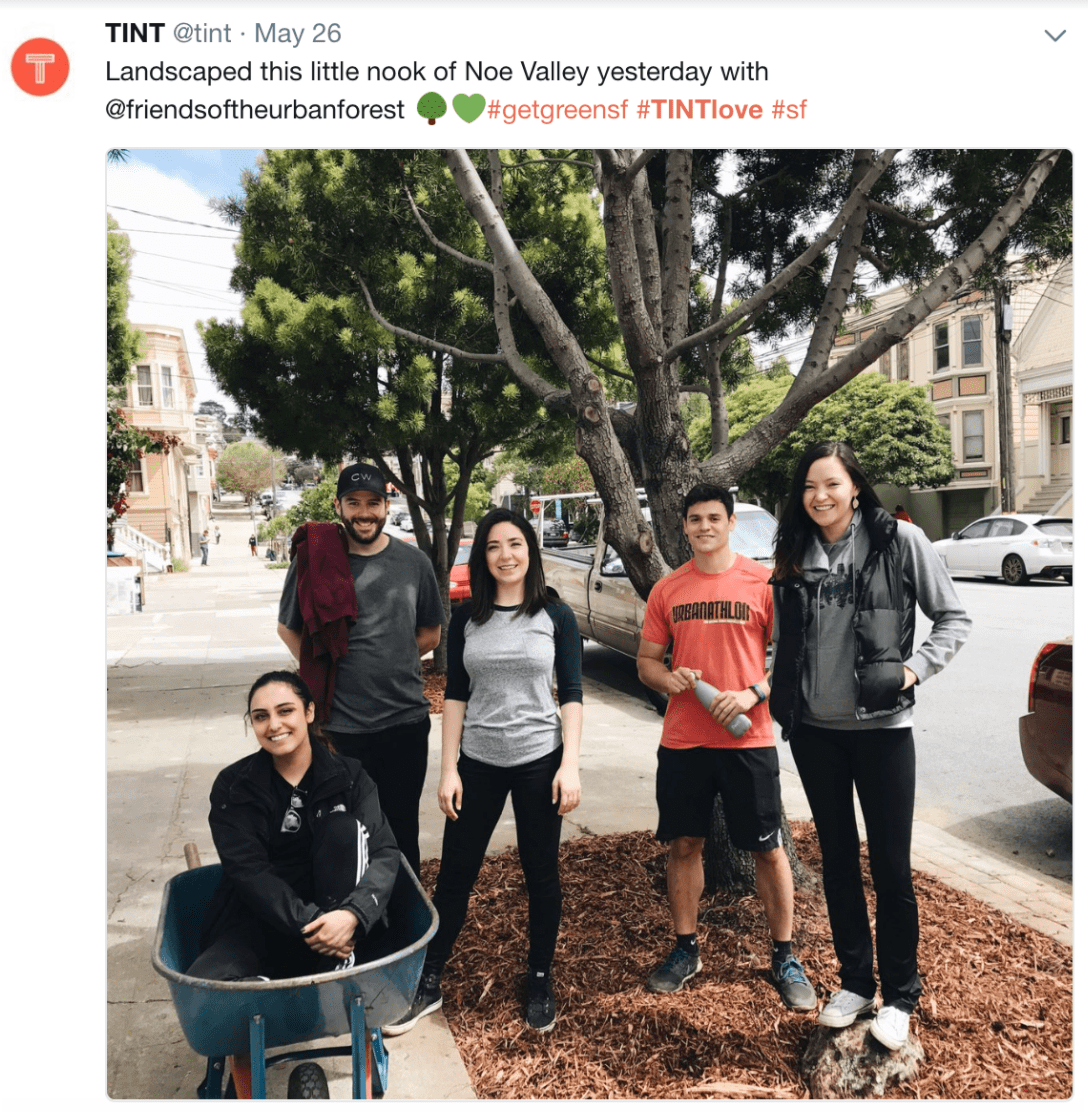
Zappos’ #ZapposCulture
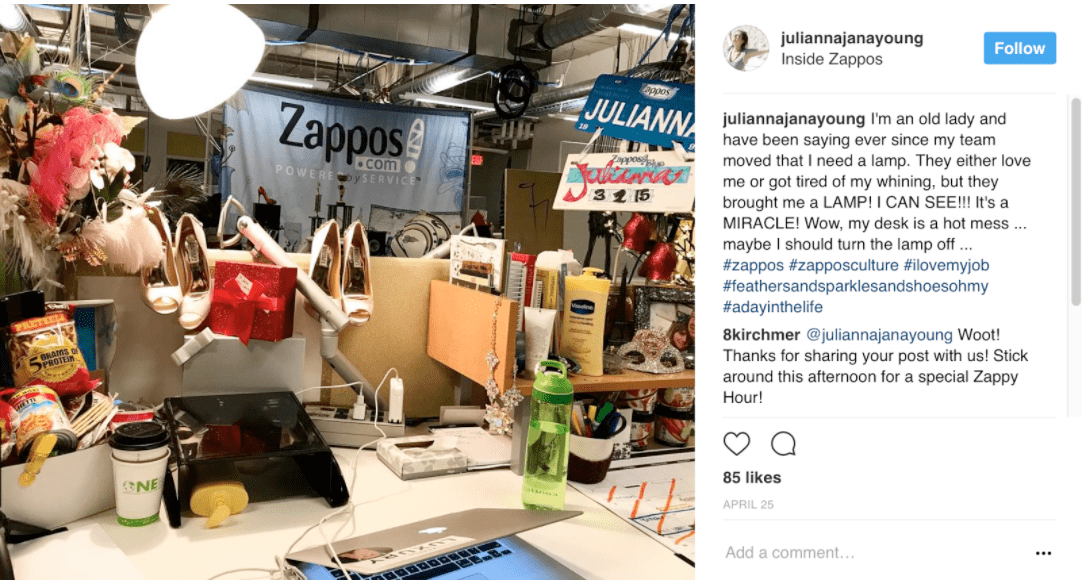
The #ZapposCulture campaign encourages Zappos employees to share their experiences inside and outside of work to reflect the culture of the brand and to connect it with its audience.
Some other employee advocacy hashtags I love
- #WeRVZW (national) + #WeRPacific (regional) – Verizon
- #StepForward – Famous Footwear
- #CondeCafeteria – CondeNast
- #DreamJob – Salesforce
So now you have your hashtag in mind, what happens next?
How to Kick Off Your New EGC Hashtag
Start by leveraging internal communication tools to bring your hashtag campaign to the forefront of everyone’s minds. Try:
- Sending out a company email (more than one email works best as people can forget about stuff the further it drifts down their inbox)
- Leverage the digital displays you have around the office to remind people of to start participating. No displays? Try some posters instead
- Sending notes on any tools you use for internal communication (like Slack, for example)
Work With a Few Employee Advocates
Obviously, it’ll take a while for people to fully get behind it and get involved, so it’s worth starting off by handpicking a few employees to help initiate it.
When content starts to consistently appear on the hashtag, more and more employees will want to get on board (FOMO is a real thing!).
Take them out on a nice lunch or just go for a walk together and take selfies. Work closely with this select group of employees to start generating the type of content you want to see more of.
Get Stationary Made
Visuals are a lot more powerful than the written word.
We’re more likely to remember something we’ve seen than something we’ve read or heard, so put this into action when getting your EGC hashtag out there.
Get visual cues made to put around the office, like stickers for computers, notebooks for desks, and water bottles that are all emblazoned with the hashtag.
Give People a Purpose
At TINT, we have a monthly self-improvement exercise for employees that is run through a unique hashtag where progress can easily be documented.
When 68% of people use social media to give others a better sense of themselves, it makes sense to cultivate a hashtag that lets them share who they are, what they’re doing and their successes.
The monthly exercise means that it’s an ongoing process where people can check back and see their progress as time goes on, as well as other employees’ progress to see how they measure up.
Run a Campaign
Not every organization will be able to do what Emirates Airlines did with their #BeingThere campaign but it’s a great way to start thinking about how to reward the employees who do share.
TINT – Emirates #BeingThere – Employee Hashtag Campaign from TINT on Vimeo.
Final Thoughts
Getting your employee advocacy campaign set up and started is the hardest part.
Once you’ve got it out there in front of your employees and they start participating, it kind of works like a snowball effect – so putting it out there in the right way is vital.
That means choosing a hashtag that represents you and your brand, as well as one that can easily be remembered.
But it also means making sure that your employees have a reason to participate and providing them with easy-to-access tools to give them the push they need to get involved.



